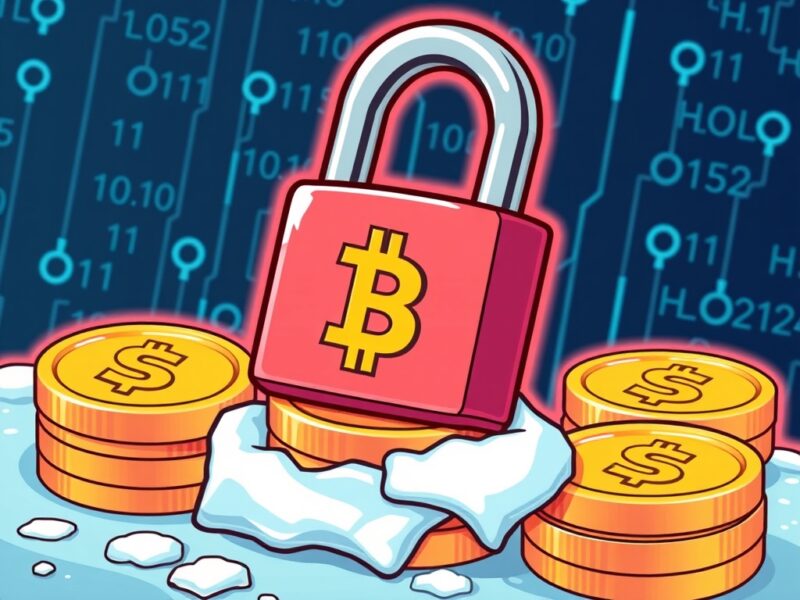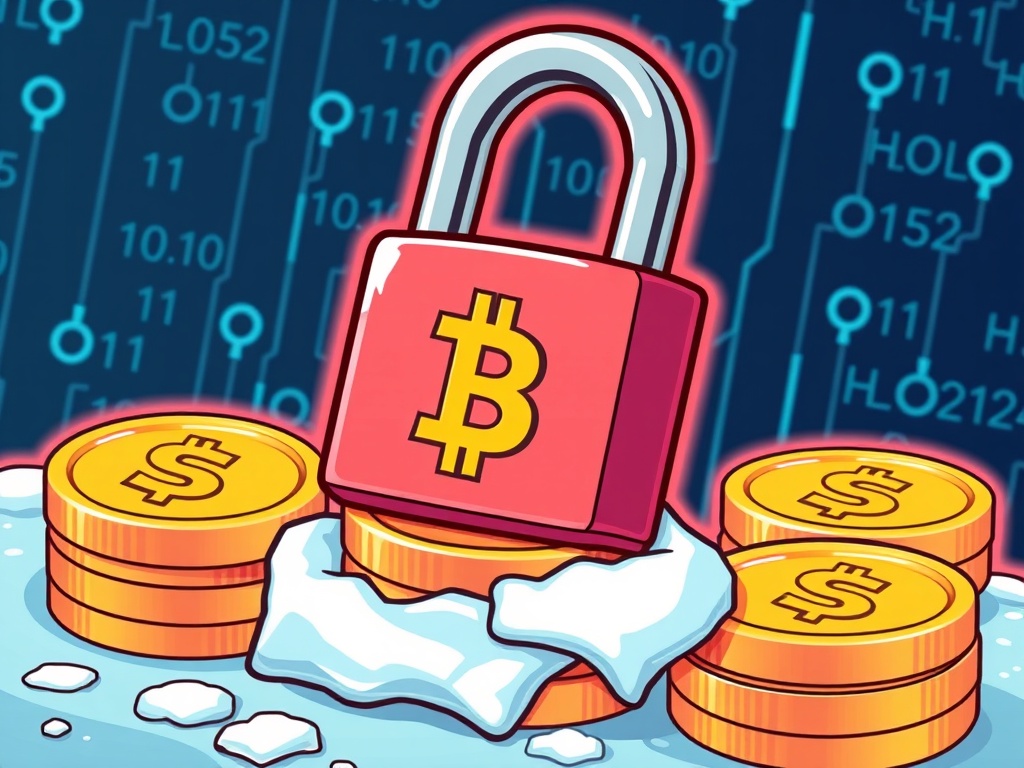Tether Freezes USDT: A Crucial $6.45 Million Move Sparks Security Concerns
0
0

BitcoinWorld

Tether Freezes USDT: A Crucial $6.45 Million Move Sparks Security Concerns
The cryptocurrency world is buzzing with news that Tether freezes USDT, specifically $6.45 million across 11 different addresses. This significant action by the issuer of the world’s largest stablecoin, USDT, has once again brought the critical balance between security, compliance, and decentralization into sharp focus. For anyone involved in digital assets, understanding the implications of such moves is paramount.
What Exactly Happened When Tether Froze USDT?
According to MistTrack, a reputable platform associated with blockchain security firm SlowMist, Tether took decisive action to freeze a substantial amount of its stablecoin. A total of 6.45 million USDT was rendered inaccessible across 11 distinct blockchain addresses. This isn’t an isolated incident; Tether has a history of collaborating with law enforcement and regulatory bodies to freeze funds linked to illicit activities.
- Specifics: $6.45 million USDT frozen.
- Scope: Across 11 different blockchain addresses.
- Source: Reported by MistTrack, a blockchain security firm.
Such interventions highlight Tether’s active role in maintaining the integrity of its ecosystem, even if it means exercising centralized control over its tokens. The power to freeze assets is a double-edged sword, offering both protection and potential concerns for users.
Why Does Tether Freeze USDT? Understanding the Reasons
When Tether freezes USDT, it’s typically not done arbitrarily. These actions are often a direct response to requests from law enforcement agencies or as part of Tether’s ongoing efforts to comply with global financial regulations. The primary goal is to prevent the use of USDT in criminal activities such as money laundering, fraud, or terrorism financing.
For a stablecoin that aims to bridge the gap between traditional finance and the crypto world, adherence to Anti-Money Laundering (AML) and Know Your Customer (KYC) policies is crucial. Tether operates under a framework that allows it to identify and block addresses suspected of wrongdoing. This commitment helps solidify its position as a regulated financial instrument, making it more appealing to institutional investors.
However, this capability also underscores a fundamental aspect of stablecoins like USDT: their centralized nature. Unlike truly decentralized cryptocurrencies, stablecoins often have a central issuer that can intervene, a point of constant debate within the crypto community.
The Broader Implications of Tether Freezes USDT for Crypto Security
The news that Tether freezes USDT carries significant implications for the entire cryptocurrency ecosystem. On one hand, it demonstrates a commitment to combating financial crime, which can enhance the legitimacy and adoption of stablecoins in the broader financial landscape. By working with authorities, Tether can help reduce the illicit use of digital assets, potentially paving the way for more mainstream acceptance.
On the other hand, the ability of a single entity to freeze millions of dollars in user funds raises important questions about censorship resistance and the core principles of decentralization that many in the crypto space value. Users of USDT, therefore, need to be aware that their assets are subject to the issuer’s policies and legal obligations.
- Enhanced Legitimacy: Helps stablecoins gain trust from regulators and traditional finance.
- Centralization Concerns: Reinforces the power of a central issuer over user funds.
- User Awareness: Highlights the need for users to understand the terms of service for stablecoins.
This dynamic creates a tension between the need for security and regulatory compliance versus the desire for absolute financial autonomy. It’s a challenge that the entire stablecoin market continues to navigate.
What Does This Mean for USDT Holders and the Crypto Ecosystem?
For individuals holding USDT, understanding the operational policies of Tether is vital. While the chances of an ordinary, law-abiding user having their funds frozen are minimal, it is a reminder that stablecoins, unlike Bitcoin or Ethereum, have an inherent level of centralized control. It encourages users to:
- Stay Informed: Keep up-to-date with Tether’s policies and any relevant regulatory changes.
- Practice Due Diligence: Ensure the source of your USDT is legitimate and avoid interactions with suspicious addresses.
- Diversify: Consider diversifying holdings across various stablecoins or other cryptocurrencies if decentralization is a primary concern.
The incident where Tether freezes USDT serves as a crucial case study. It highlights the ongoing evolution of digital asset regulation and the responsibilities stablecoin issuers take on. As the crypto market matures, these types of interventions will likely become more common, shaping how we perceive and interact with digital money.
In conclusion, Tether’s decision to freeze $6.45 million in USDT across 11 addresses is a powerful reminder of the complex interplay between security, regulation, and decentralization in the crypto world. While it underscores Tether’s commitment to combating illicit activities and complying with legal mandates, it also reignites debates about the centralized nature of stablecoins. For users, staying informed and exercising caution remains the best strategy in this evolving digital financial landscape. The future of stablecoins will undoubtedly continue to balance these competing priorities.
Frequently Asked Questions (FAQs)
Q1: What is USDT?
A1: USDT is a stablecoin issued by Tether, pegged to the US dollar. This means its value is intended to remain stable, typically at $1 USD, making it a popular choice for trading and transferring value within the crypto market.
Q2: Why can Tether freeze user funds?
A2: As a centralized issuer, Tether has the technical capability to freeze USDT tokens on the blockchain. They typically exercise this power in response to law enforcement requests, court orders, or to prevent funds from being used in illegal activities like money laundering or fraud, aligning with their regulatory compliance efforts.
Q3: How often does Tether freeze USDT?
A3: While not an everyday occurrence, Tether has frozen funds on multiple occasions over the years, usually targeting addresses linked to scams, hacks, or other illicit activities as reported by security firms or law enforcement.
Q4: What should I do to protect my USDT from being frozen?
A4: The best protection is to ensure your USDT comes from legitimate sources and that you do not engage in any activities that could be deemed illegal or suspicious. Always use reputable exchanges and wallets, and avoid interacting with unknown or untrustworthy addresses.
Q5: Does this mean all stablecoins can be frozen?
A5: Most centralized stablecoins (like USDC, BUSD, etc.) have similar capabilities to freeze funds to comply with regulations. Decentralized stablecoins (like DAI) are designed to operate without a central issuer, making them generally immune to such direct interventions, though they have their own set of risks.
If you found this article insightful, please consider sharing it with your network! Help us spread awareness about critical developments in the cryptocurrency space by sharing on social media.
To learn more about the latest crypto market trends, explore our article on key developments shaping stablecoin institutional adoption.
This post Tether Freezes USDT: A Crucial $6.45 Million Move Sparks Security Concerns first appeared on BitcoinWorld and is written by Editorial Team
0
0
 Manage all your crypto, NFT and DeFi from one place
Manage all your crypto, NFT and DeFi from one placeSecurely connect the portfolio you’re using to start.






